AMD Phenom II X4 980 Black Edition Review
by Anand Lal Shimpi on May 2, 2011 10:42 PM ESTAMD has hardly kept quiet on the CPU front these past several months. At the beginning of the year AMD put the nail in Atom's netbook coffin with the Brazos platform, and last month it announced the first shipments of Llano APUs to OEMs. Expect an official launch of Llano to follow sometime in the next two months.
AMD's focus on the mainstream echoes to a certain extent its GPU strategy: focus on the bulk of the customers first, then address the smaller high end of the market. Despite an overly controlling stance on overclocking and issues with B2 stepping 6-series chipsets, Intel's Sandy Bridge (Core ix-2xxx) dominates the high end. AMD will make a go for that market later this year with its Bulldozer architecture. It's still too early for an accurate preview of Bulldozer performance, although the time for such a thing is quickly approaching.
Until Bulldozer's unveiling, the Phenom II remains as AMD's high end platform. Today, that very platform gets a little boost.
The Phenom II X4 980 Black Edition release marks a speed bump and a price drop for the quad-core Phenom II family. The 980 assumes the $195 price point, with everything else stepping down a notch in pricing:
| CPU Specification Comparison | ||||||||
| Processor | Clock Speed | Max Turbo | L2 Cache | L3 Cache | TDP | Price | ||
| AMD Phenom II X6 1100T | 3.3GHz | 3.7GHz | 3MB | 6MB | 125W | $239 | ||
| AMD Phenom II X6 1090T | 3.2GHz | 3.6GHz | 3MB | 6MB | 125W | $205 | ||
| AMD Phenom II X6 1075T | 3.0GHz | 3.5GHz | 3MB | 6MB | 125W | $195 | ||
| AMD Phenom II X6 1065T | 2.9GHz | 3.4GHz | 3MB | 6MB | 125W | $185 | ||
| AMD Phenom II X6 1055T | 2.8GHz | 3.3GHz | 3MB | 6MB | 125W | $175 | ||
| AMD Phenom II X4 980 BE | 3.7GHz | N/A | 2MB | 6MB | 125W | $185 | ||
| AMD Phenom II X4 975 BE | 3.6GHz | N/A | 2MB | 6MB | 125W | $175 | ||
| AMD Phenom II X4 970 BE | 3.5GHz | N/A | 2MB | 6MB | 125W | $155 | ||
| AMD Phenom II X4 965 BE | 3.4GHz | N/A | 2MB | 6MB | 125W | $135 | ||
Architecturally there are no surprises here. The 980 comes with a 6MB L3 cache shared by all of its cores and 512KB private L2s per core. The chip is built on Global Foundries' 45nm process with a 258mm^2 die size and around 758M transistors. TDP remains at 125W and the chip should work in all Socket-AM3 motherboards.
Don't expect any performance surprises here. The 980's closest competitor is Intel's Core i5 2400 a four core, four thread offering clocked at 3.1GHz by default with a 3.4GHz max turbo. Single threaded performance is clearly a win for the Core i5 2400:

Multithreaded performance ranges from equal between the two:
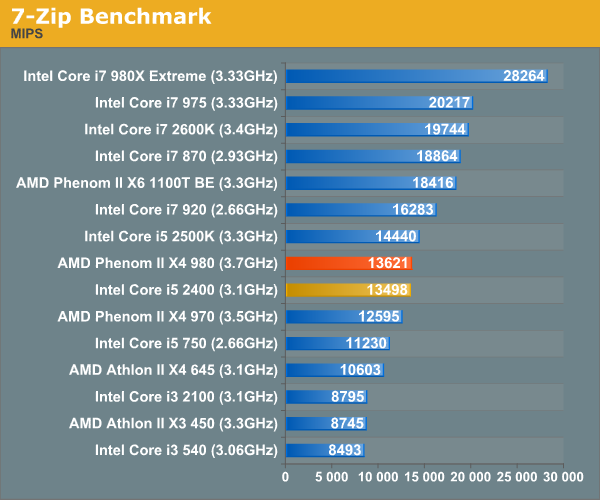
...to another win for the Core i5 2400:
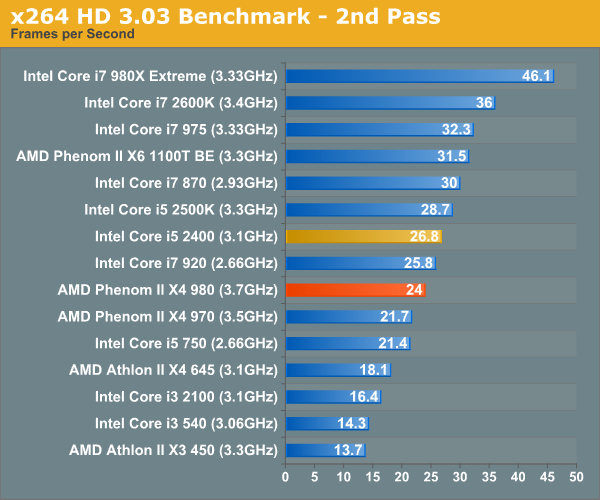
Typically the Core i5 2400 wins across the board. Load power consumption is also an advantage:
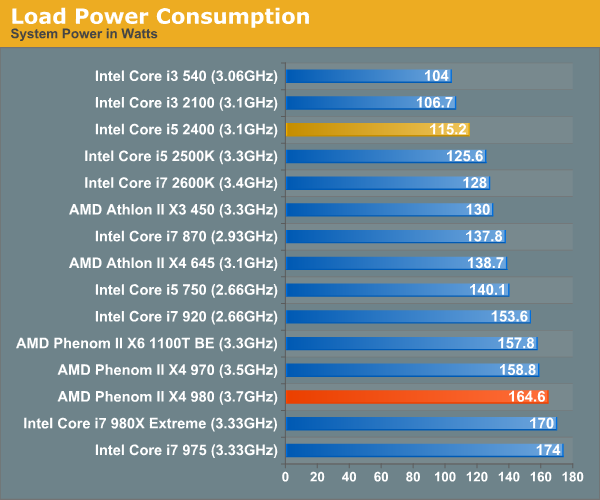
The only advantage AMD offers is a fully unlocked CPU that can be overclocked as far as physics will allow. On our sample that meant 4.2GHz with the stock cooler. Given enough voltage hitting 4GHz+ on air isn't a problem:
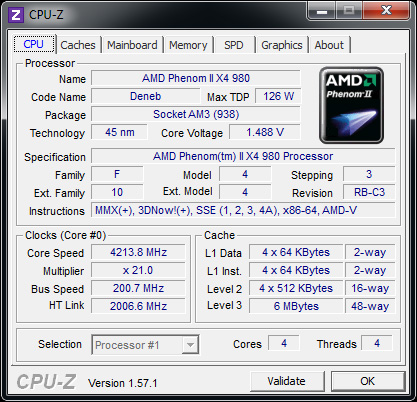
Unfortunately even while overclocked the Phenom II X4 980 can't muster enough performance to put a stock Core i5 2400 to shame:
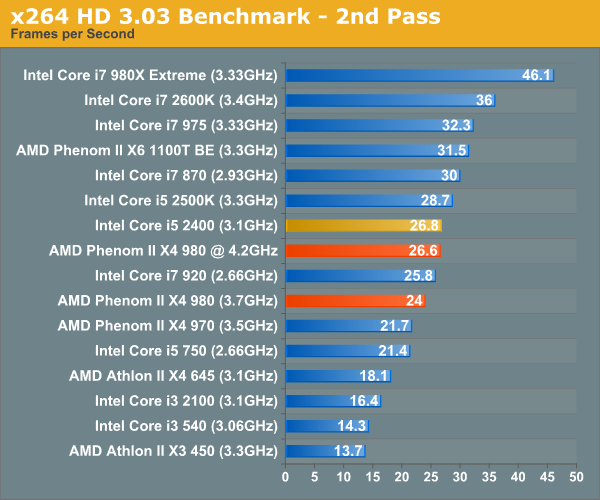
At 4.2GHz the 980 is fast enough to equal the 2400 in our x264 test and perhaps slightly surpass it in a benchmark that favors AMD's Phenom II architecture. But for the most part, even overclocked, the Phenom II X4 980 won't be worth it over Sandy Bridge.




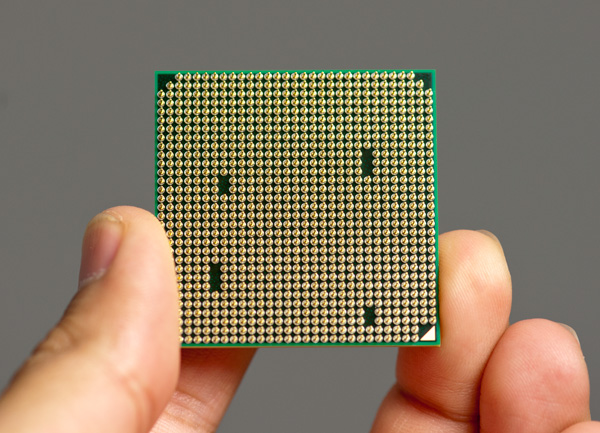








78 Comments
View All Comments
silverblue - Wednesday, May 4, 2011 - link
Phenom II came to market after Nehalem. Yes, it wasn't exactly meant to compete with it, and was more about sorting out what Phenom did wrong, but the unfortunate truth is that the i7 beat it to market.529th - I think the issue would be that you would be disabling a feature and thus not showing accurate performance, however that in itself would show the difference given by having Turbo in the first place. Doing the same with Thuban would be interesting.
Zosma would've made more sense than continuing on with Deneb, however AMD quickly shelved that idea.
GullLars - Wednesday, May 4, 2011 - link
Nah, it's just Intel has a huge advantage on fabs. They also have a clock for clock advantage on most workloads, but AMD's engineers are by no means incompetent. Brazos is the only recent great product though.If both Bulldozer and Lano fails spectacularly, i'll start leaning towards your side though. The last years Intel have alienated me with horrible business ethics and artificial restrictions on processors for market segmentation with very high prices on the chips that were not gimped (disabled functional units).
Hopefully power consumption will be better with GloFo.
silverblue - Wednesday, May 4, 2011 - link
Weren't you banned? No? Oh.Intel actually DOES need to make its compilers more vendor-agnostic since the settlement. If a piece of software works rather poorly on an AMD CPU and much better for an Intel offering, this isn't always down to the Intel CPU being stronger; it might actually be the result of the AMD CPU working on an inefficient codepath. Of course, it may actually be the limit of the processor. If something is compiled using a neutral compiler, I'd be far more inclined to trust the results of that.
I doubt Intel is forcing people to use their compiler nor are they making them develop for Intel-only platforms, however in the interests of fair competition it's only right that checking for the CPU ID tag be removed, if that is what they're doing.
silverblue - Wednesday, May 4, 2011 - link
Since you're such an expert, could you perhaps tell us, oh mighty one, what errata requires fixing? What is so buggy about an AMD processor?If you're going to make such bold statements, it's about time you actually backed them up with FACTS.
silverblue - Thursday, May 5, 2011 - link
Still waiting.silverblue - Wednesday, May 4, 2011 - link
The most popular CPUs are towards the lower end. Intel doesn't have a quad core CPU below $100 whereas AMD has multiple. There's no reason why an Athlon II X4 setup shouldn't easily undercut an i3 setup, and occasionally, four true cores will be a benefit.wh3resmycar - Wednesday, May 4, 2011 - link
why and why would are you still guys sticking to 1680x1050? don't give me the crap about correctly segmenting processor performance hence a cpu bound resolution for gameX.people who actually are gamers, who are looking for a quadcore and up cpu solutions are probably gaming at HD resolutions and upwards.
at least add graphs that are done on higher resolutions. your gaming performance benchmarks don't work in the real world.
stimudent - Sunday, May 8, 2011 - link
This is great hardware, but it seems that most everyone I know who is an average user has left their tower systems and switched to smart phones, iPads, and gaming consoles for the most part. These items are now being discussed at family get togethers instead of PCs as was the case just a few years ago. Some advanced users are using the latest graphics cards for computational projects instead of gaming - the CPU is no longer seen as the best way to fold. It's the graphics card doing the grunt work while the quad-core processor sits mostly idle.